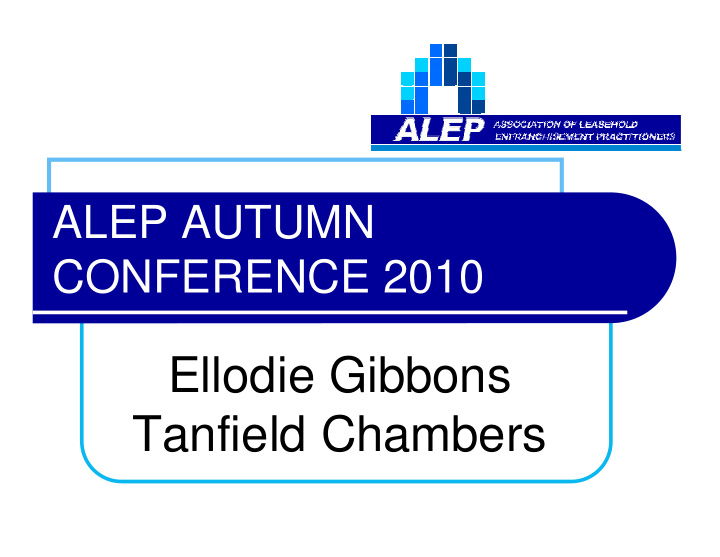



ALEP AUTUMN CONFERENCE 2010 Ellodie Gibbons Tanfield Chambers
Ellodie Gibbons Legal Loopholes in � Enfranchisement Recent decisions �
Qualification under the ’67 Act By virtue of section 2(1) a ‘house’ is a building, which: is designed or adapted for living in; � can reasonably be called a house; � does not have to be detached; � may be divided horizontally into flats or maisonettes; � and is not divided vertically. �
Business Tenants General rule tenants of business tenancies within the meaning of Part 2 of the Landlord and Tenant Act 1954 do not have a right to acquire the freehold. Exceptions - sections 1(1ZC) and (1ZD) � The tenancy is for a term of more than 35 years; and � The tenant has been occupying the house, or any part of it, as his only or main residence for the last two years or for periods amounting to two years in the last ten years. (ss.1(1ZC) and (1B)).
Vote Should business tenants be able to acquire their landlord’s freehold? A. Yes 20.5% B. No 79.5%
The ’54 Act 23 - (1) Subject to the provisions of this Act, this Part of this Act applies to any tenancy where the property comprised in the tenancy is or includes premises which are occupied by the tenant and are so occupied for the purposes of a business carried on by him or for those and other purposes.
Day v. Hosebay � Three terraced properties, originally constructed and occupied as large houses � Hosebay Ltd, as tenant, occupied the properties for the purposes of a business, ‘Astons Apartments’ � Astons Apartments provides short term accommodation for tourists and other visitors to London � Hosebay sub-let the houses to Hindmill Ltd, an associated company
Issues The underleases were not shams, therefore, were the properties - (1) designed or adapted for living in; and (2) houses reasonably so called
Issue 1 � Each of the properties was “designed…for living in” � That was not sufficient � Look at the most recent works � Assess, objectively, whether they resulted in the property being adapted for living in � Each of the houses was adapted for living in even if that was not their current use
Vote Should either “designed” or “adapted” be sufficient? A. Yes 43.8% B. No 56.2%
Issue 2 The question whether a building is a “house…reasonably so called” is to be determined essentially by reference to its external and internal physical character and appearance All the subject properties were houses reasonably so called
Prospect Estates � Building built as a residential house � Essential structure of remained unchanged � The lease stipulated that 88.5% of the building was to be used as offices and 11.5%, or one storey, was to be used as a residential flat � Not a house reasonably so called
Vote Was the decision in Hosebay the correct one A. Yes 49.2% B. No 50.8%
Vote How should the issue of business tenants be addressed? A. business premises are not designed or adapted for living in 23.5% B. business premises are not houses reasonably so called 40.9% C. business tenancies should not be defined by reference to the ’54 Act 15.2% D. an artificial sub-letting is a sham 10.6% E. some other answer 9.8%
Other loopholes LRHUDA 1993 Section 5(5) – no qualifying tenant where one tenant owns more than two flats Avoided if lease is transferred e.g. to a trustee
Vote Choose one: A. There should be no restriction in section 5(5) 33.1% B. The status quo should remain 21.3% C. The loophole should be closed 45.6%
Supplementary vote Should we restore the residency provision? 1. Yes 38.2% 2. No 61.8%
Recent Cases � 41 – 60 Albert Place Mansions (Freehold) Ltd v. Craftrule Ltd [2010] EWCA Civ 1230 � Ashdown Hove Ltd v. Remstar Properties Ltd (2010) (2010) 37 EG 138 � HILMI & Associates Ltd v 20 Pembridge Villas Freehold Ltd (2010) (2010) 3 All ER 391 � Grosvenor Estate Belgravia v (1) Craig Wayne Klaasmeyer (2) Ashley Dierker Klaasmeyer (2010) (2010) 16 EG 107 (CS) � (1) Earl Cadogan (2) Cadogan Estates Ltd v (1) Alexander Dimitris Nicholas Panagopoulos (2) John Matthew Stephenson (2010) (2010) L & TR 13
Recommend
More recommend